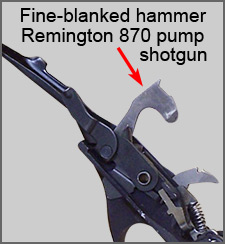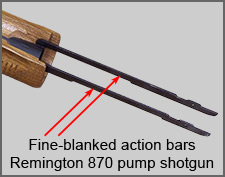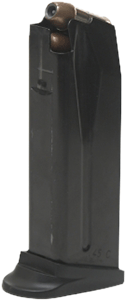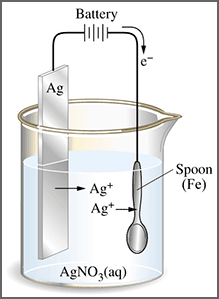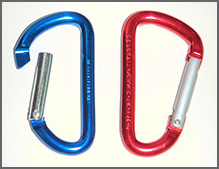Home | Glossary | Resources | Help | Contact Us | Course Map
Archival Notice
This is an archive page that is no longer being updated. It may contain outdated information and links may no longer function as originally intended.
Low-Stress Load Parts
| Stress Loads | |
| High-Stress Load Parts: | Low-Stress Load Parts: |
|
Frame or receiver |
Lockwork or lock parts |
|
Slide |
Repeating mechanism components |
|
Bolt or breechblock |
Small pins, screws, and springs |
|
Cylinder |
Detachable magazines |
Low-stress parts present special manufacturing challenges due to their smaller size and the large variety and quantity required for assembly. The components may be part of the firing mechanism or lockwork, the repeating mechanism, or may be springs, screws, and pins for attaching other parts.
Lock Parts
Although seldom affected by the pressure generated by a fired cartridge, hammers and triggers must withstand repeated shock of operation and recoil. The manufacturing process used depends on the final desired shape of the part. Hammers and triggers that are not considered a cosmetic item can be fine blanked. This is common in low-cost commercial rifles and shotguns and in some military arms. The precision of fine blanking requires minimal final fitting. The process is limited to parts that are essentially slab sided (uniform thickness) where appearance is not a major factor.
For example, one maker of quality revolvers fitted some of their most popular models with slab-sided hammers and triggers. However, their marketing image made stamped parts unacceptable. Before CNC was developed, the firms engineers developed a unique approach to economically create high-strength milled hammers and triggers. A solid bar of forged steel was progressively fed through several milling machines to create the complex side profile of these parts. Viewed end-on, the bar looked like the finished hammer or trigger, but was approximately eighteen inches (46 cm) long. The shaped part was fed into an automated saw; hammers and triggers were sliced off like salami. The parts needed only minor milling and drilling before being sent to finishing and assembly.
For hammers and triggers that vary significantly in thickness, forging was standard for years. Today, investment casting and/or powdered metal technology are replacing forging. Either process can easily produce cavities, steps, and recesses that would require machining in a forged part.
Smaller parts of the lockwork, such as a sear, safety, or disconnector device are usually complex shapes that do not lend themselves to low-cost fine blanking. They all require precision for safety. CNC milling is still common, but investment casting and PMT have both made inroads due to their ability to reproduce complex shapes.
Most firing pins are rod shaped and symmetrical. Turning on automated lathes is the preferred manufacturing method. A magazine is loaded with precut rods feeding work to a cutting unit. The rod is mounted, profiled to a set pattern, and unmounted in a controlled cycle. The use of a common cutter can produce coarse marks (known as subclass characteristics) that may repeat between pins. The wise examiner approaches concentric firing pin marks with caution.
Repeating Mechanism Components
Because repeating mechanisms vary greatly in form and function, it is difficult to generalize regarding their manufacture. However, one type of repeating mechanism (used in pump-action and semiautomatic shotguns) is uniform in design and manufacture. The major parts are one or two shell latches and the operating rod (or action bar) that connects the pump handle or gas cylinder to the bolt mechanism. Regardless of the manufacturer, fine blanking is the method of choice for these parts. Most are flat and can be made from sheet metal. Proper fine blanking can produce the needed protrusions that many such parts use to control shotshells position. Shell latches can leave identifiable marks on shotshells; the blanked edge of the latches often makes contact with shotshells.
Small Pins, Screws, and Springs
Traditionally, gunmakers manufactured all firearms parts. Today, trends in manufacturing call for the outsourcing of small parts. This is the preferred method, even if it requires slight modification of the firearm to accept off-the-shelf parts.
Detachable Magazines
For decades, detachable box magazines have been constructed of thin sheet steel. The basic two-dimensional shape is fine blanked and folded to make the box. Seams are secured by interlocking or welding. The follower and springs are added to complete the magazine.
Recent trends toward using alternate materials gave rise to polymer magazines. Depending on the design requirements, metal feed lips are either cast into the main body or added during assembly.
Magazines can leave useful marks on the side of a cartridge case. It behooves the examiner to carefully determine the magazine construction before rendering a final opinion. Stamped metal magazine lips seldom exhibit carryover marks. On the other hand, cast metal feed lips (Ruger Model 10/22 and similar magazines) may leave few marks but have a greater chance of carryover from one magazine to another.
Cosmetic Finish
The external finish on a firearm enhances the appearance and provides protection. An effective surface finish, whether on metal or wood, preserves the value of the firearm and protects it from environmental damage.
Depending upon the gun design and the manufacturers workflow, cosmetic finishing may be applied before or after final fitting and assembly. Final cosmetic finishing is applied to the vast majority of guns before assembly.
Prior to the American Civil War (1861-1865), the standard metal finish for most military rifles and muskets was polished bare metal. Although polishing removed tooling marks, the surface was neither protected nor colored. As a result of a slow oxidation process, these firearms develop a brown surface called patina.
Starting with the 1873 U.S. Springfield, the U.S. military adopted commercial finishes. To enhance sales appeal, finishes are applied to commercial firearms. The most common metal finish in the industry is blued steel; the metal is chemically oxidized to produce a dark blue finish. Electroplating and anodizing are also routinely used methods for finishing firearms.
Bluing
Bluing is used on steel metal parts to provide a protective coating. This involves an oxidizing chemical process that provides some protection against corrosion. Depending on the specific process, the resulting coating appears as a blue or blue-black color on the metal exterior.
Electroplating
The electroplating process provides a protective coating to different types of metal. The most common use in firearms manufacturing is chrome or nickel plating, which provide a bright finish to the metal. Electroplating can be used on various types of metals; the result is a thin metal coating on the exterior of the original metal part.
Anodizing
Anodizing is used to provide a protective coating for aluminum and titanium. The process produces a controlled oxidized surface similar to bluing. Like the electroplating process, anodizing uses electrical current. Different colors can be produced in this process; black is the most common for firearms parts.
Other finishes that the firearm examiner may encounter include Parkerizing (phosphating coatings applied to steel), case hardening, and various paints.
Additional Online Courses
- What Every First Responding Officer Should Know About DNA Evidence
- Collecting DNA Evidence at Property Crime Scenes
- DNA – A Prosecutor’s Practice Notebook
- Crime Scene and DNA Basics
- Laboratory Safety Programs
- DNA Amplification
- Population Genetics and Statistics
- Non-STR DNA Markers: SNPs, Y-STRs, LCN and mtDNA
- Firearms Examiner Training
- Forensic DNA Education for Law Enforcement Decisionmakers
- What Every Investigator and Evidence Technician Should Know About DNA Evidence
- Principles of Forensic DNA for Officers of the Court
- Law 101: Legal Guide for the Forensic Expert
- Laboratory Orientation and Testing of Body Fluids and Tissues
- DNA Extraction and Quantitation
- STR Data Analysis and Interpretation
- Communication Skills, Report Writing, and Courtroom Testimony
- Español for Law Enforcement
- Amplified DNA Product Separation for Forensic Analysts


